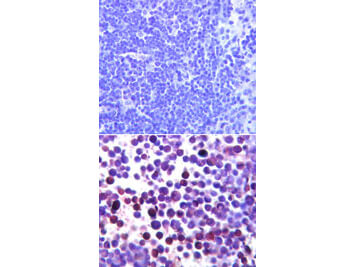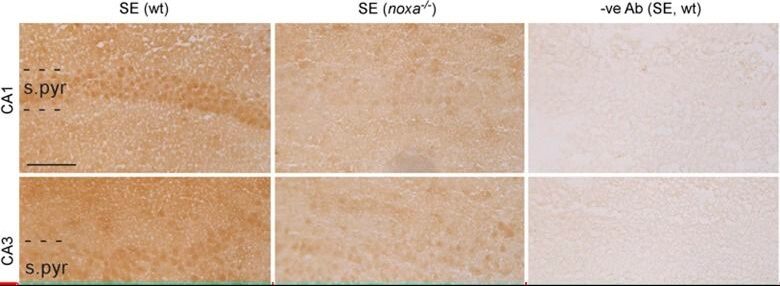Datasheet is currently unavailable. Try again or CONTACT US
NOXA Antibody
Mouse Monoclonal 114C307.1 IgG1 kappa
2 References
200-301-H98
100 µg
Liquid
WB, IHC, IF, FC
Human, Mouse
Mouse
Shipping info:
$50.00 to US & $70.00 to Canada for most products. Final costs are calculated at checkout.
Product Details
Anti-NOXA (MOUSE) Monoclonal Antibody - 200-301-H98
NOXA, Phorbol-12-myristate-13-acetate-induced protein 1, PMA-induced protein 1, Immediate-early-response protein APR, Protein Noxa
Mouse
Monoclonal
IgG1
Target Details
PMAIP1 - View All PMAIP1 Products
Human, Mouse
Recombinant Protein
Noxa Antibody was produced in mice prepared by repeated immunizations with the human protein Noxa.
Anti-Noxa Antibody was purified by Protein G chromatography. A BLAST analysis was used to suggest cross-reactivity with Anti-Noxa from human and mouse based on 100% homology with the immunizing sequence. Cross-reactivity with Anti-Noxa from other sources has not been determined.
Application Details
FC, IF, IHC, WB
Anti-Noxa antibody is tested for use by WB, Flow, ICC/IF, IHC, and IHC-P. Expect a band approximately 6 kDa on specific lysates. Specific conditions for reactivity should be optimized by the end user.
Formulation
1.0 mg/mL by UV absorbance at 280 nm
0.02 M Potassium Phosphate, 0.15 M Sodium Chloride, pH 7.2
0.05% (w/v) Sodium Azide
Shipping & Handling
Dry Ice
Store vial at -20° C prior to opening. Aliquot contents and freeze at -20° C or below for extended storage. Avoid cycles of freezing and thawing. Centrifuge product if not completely clear after standing at room temperature. This product is stable for several weeks at 4° C as an undiluted liquid. Dilute only prior to immediate use.
Expiration date is one (1) year from date of receipt.
Anti-Noxa antibody detects human Noxa. Recently, a BH-3 only member of the Bcl-2 family have been identified in human and mouse and designated as Noxa (for damage). The expression of the Noxa gene involves direct activation of its promoter by p53. Increased expression of Noxa protein occurs in normal thymocytes but not in p53-deficient thymocytes. Noxa cDNA codes for a 103-amino acid protein. The coimmunoprecipitation data suggest that Noxa protein may interact with proteins belonging to the Bcl-2 family, such as, Bcl-XL and Mcl-1. Oda et al. have also shown that blocking the endogenous Noxa induction results in the suppression of apoptosis. Treatment of cells with Noxa antisense oligonucleotides blocks radiation-induced apoptosis suggesting that Noxa may represent a mediator of p53-dependent apoptosis. Anti-Noxa antibody is ideal for investigators involved in apoptosis research.
Haschka, M.D. et al. (2020). MARCH5-dependent degradation of MCL1/NOXA complexes defines susceptibility to antimitotic drug treatment. Cell Death Differ
Applications
WB, IB, PCA
Ichikawa et al. (2017). Deletion of the BH3-only protein Noxa alters electrographic seizures but does not protect against hippocampal damage after status epilepticus in mice. Cell Death & Disease
Applications
IHC, ICC, Histology
This product is for research use only and is not intended for therapeutic or diagnostic applications. Please contact a technical service representative for more information. All products of animal origin manufactured by Rockland Immunochemicals are derived from starting materials of North American origin. Collection was performed in United States Department of Agriculture (USDA) inspected facilities and all materials have been inspected and certified to be free of disease and suitable for exportation. All properties listed are typical characteristics and are not specifications. All suggestions and data are offered in good faith but without guarantee as conditions and methods of use of our products are beyond our control. All claims must be made within 30 days following the date of delivery. The prospective user must determine the suitability of our materials before adopting them on a commercial scale. Suggested uses of our products are not recommendations to use our products in violation of any patent or as a license under any patent of Rockland Immunochemicals, Inc. If you require a commercial license to use this material and do not have one, then return this material, unopened to: Rockland Inc., P.O. BOX 5199, Limerick, Pennsylvania, USA.



